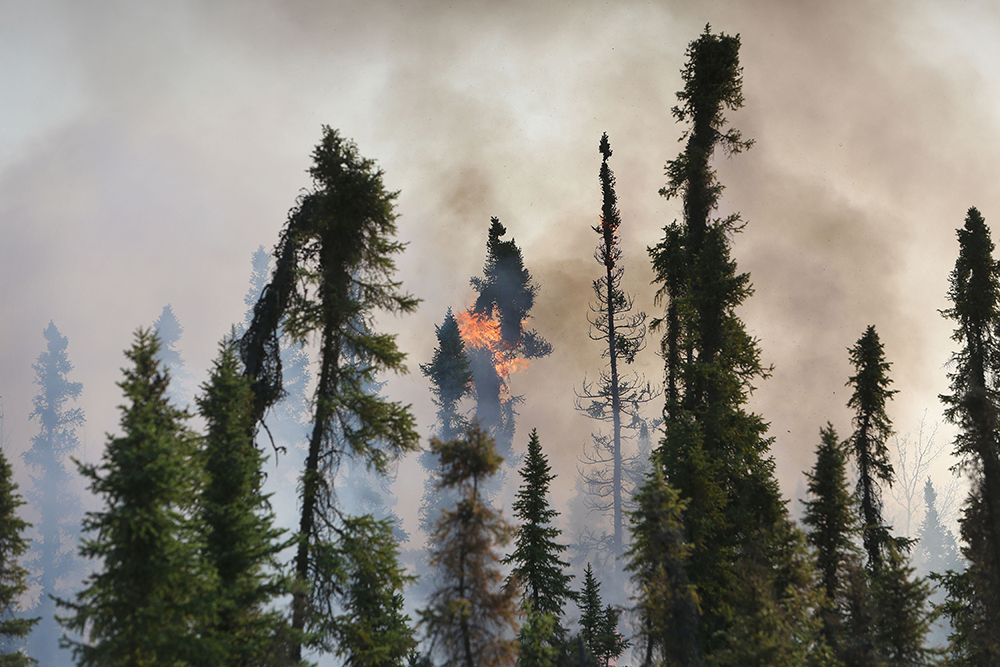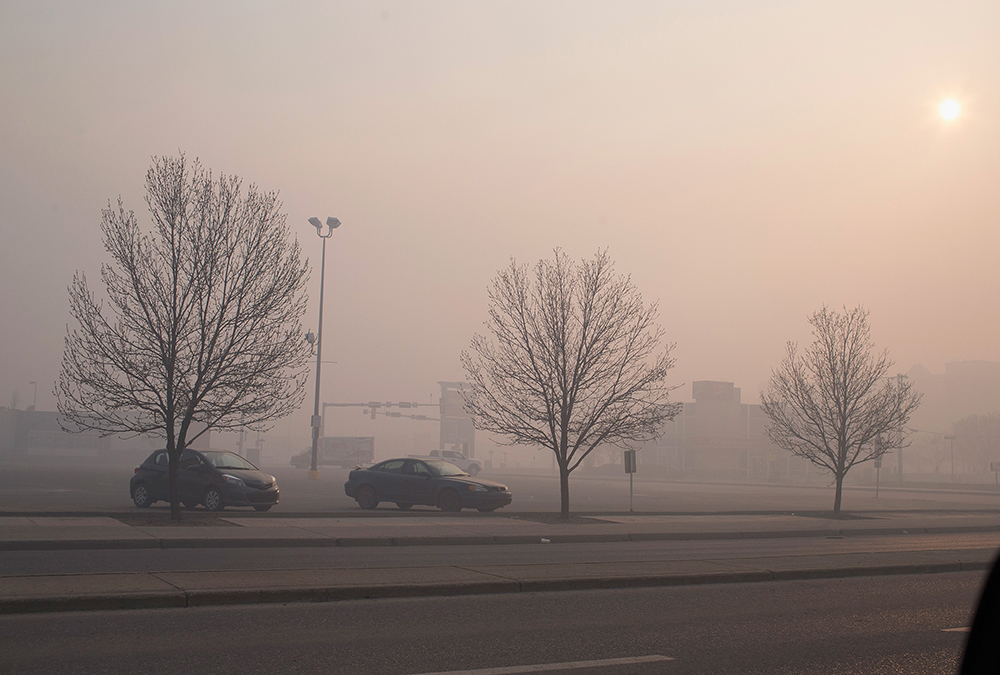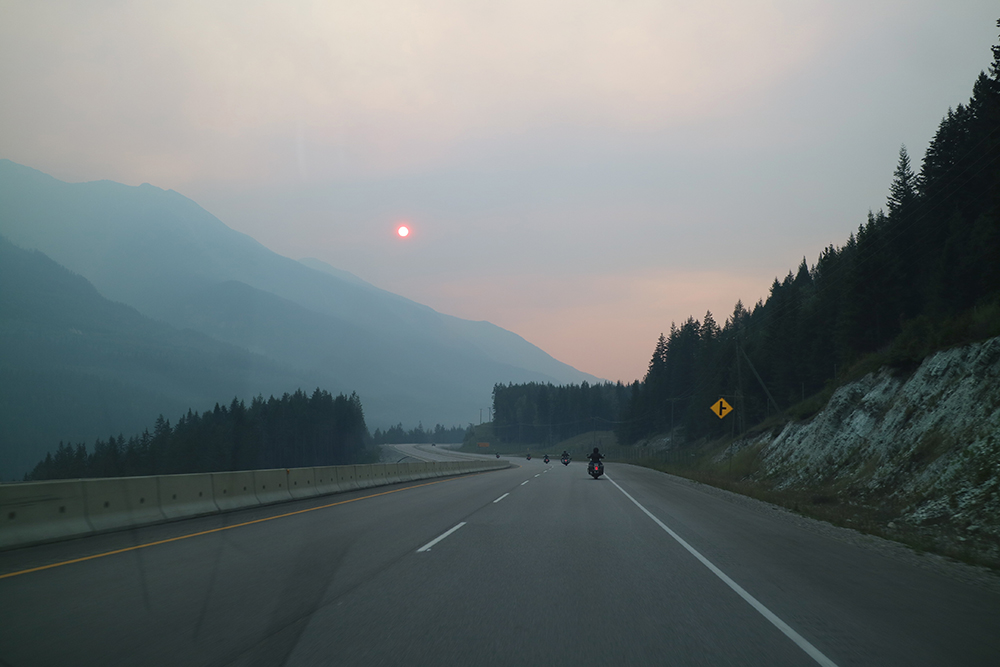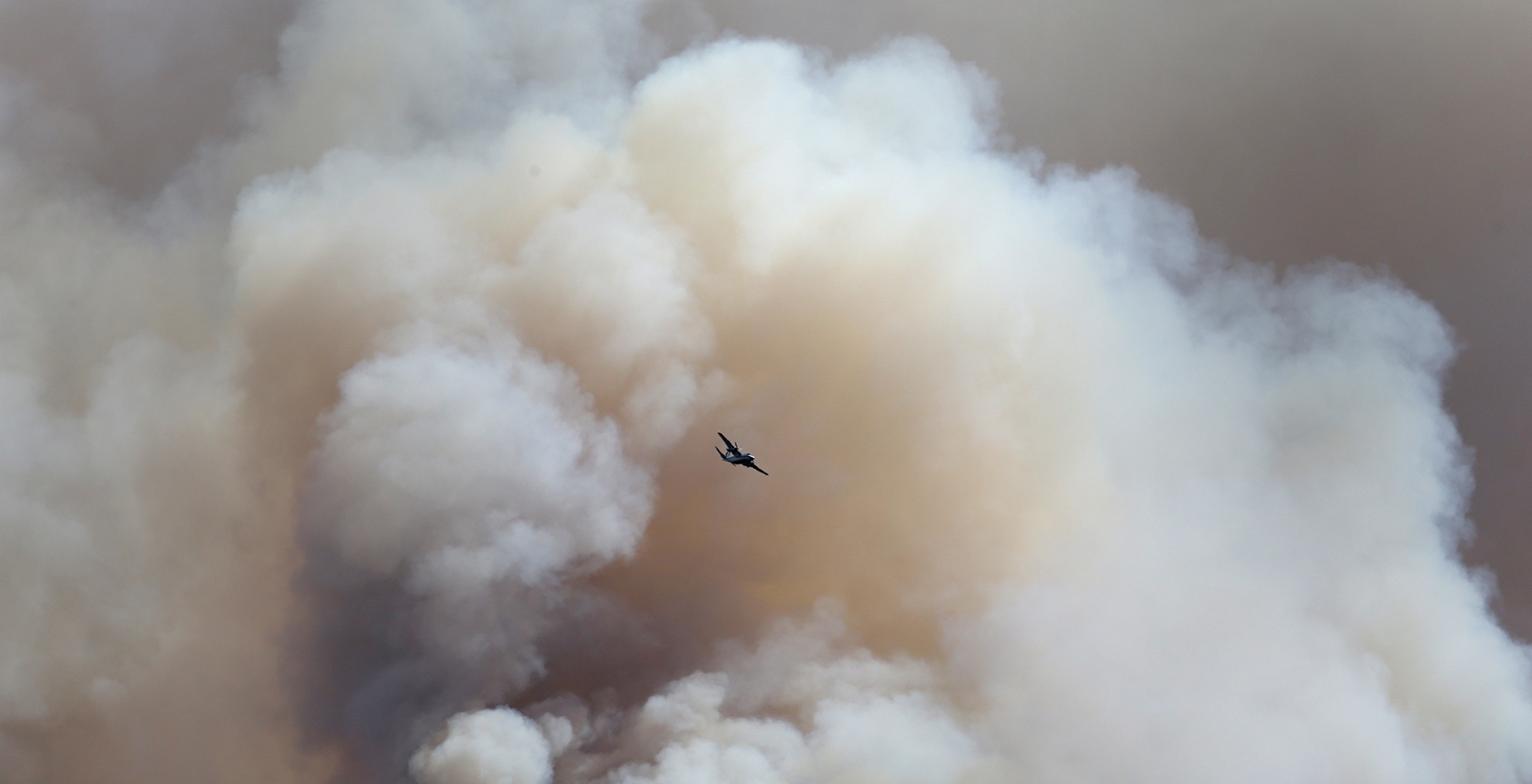How Western Canada Burned Last Summer — and Why It’s About to Get Much Worse
As Lyle Wilson tells it, had the winds shifted a bit more, the fire would have come “screaming down the ridge like a bat out of hell,” devouring the stands of mountain beetle–choked pines, shooting a volley of sparks ahead and priming the trees for the incoming wall of flame.
The scattered rental cabins his family operates year-round, and the 125 kilometres of nature trails it fastidiously maintains amid the Rocky Mountains, would be reduced to a charred expanse of ash.
The blaze had started off as a routine midsummer lightning strike, a crackling fire about the size of a car. After hikers warned him about the thin plume of smoke they’d seen, Wilson quickly called the authorities. It was the fifth fire he’d reported in recent years.
Authorities, however, already had their hands full.
Across Western Canada this summer, more than 600 blazes threatened countless communities and ripped through 1.3 million acres of forest in B.C. alone, making it the worst year for fires in the province’s history, narrowly eclipsing 2017, which burned 1.2 million acres.
Fires are a common part of life in much of the country. Cities continue their relentless push further and further into the forest, constructing housing developments and weekend getaways that sidle up alongside vast tracts of tinder. Experts agree that climate change is poised to make things much worse, and governments must finally reckon with the prospect of exacerbating a tangled history of failed forestry and fire policies.
Already, the impact is hard to ignore: last year, 45,000 people in British Columbia fled their communities, according to the Red Cross. The previous year, more than 70,000 people were forced from their homes in Alberta. Fires also have a long reach: this summer, the smoke, which carried across the continent and blacked out some cities, made Vancouver’s air quality the worst in the world.
Less than a week after Wilson reported the fire, violent winds descended into the valley. In a single day, the fire grew from a handful of hectares to over one thousand.

On the evening of August 10th, a convoy of RCMP officers arrived at Nipika Mountain Resort to evacuate a wedding party in full celebration. Staff frantically moved guests to Radium, the nearest town. Wilson tried returning to the resort to salvage his life’s work, but was blocked by police. That night began a weeks-long wait as the fire roared closer and closer. “We were just desperate,” he says. “The scale, as well as the severity, of the fires we’re seeing today is quite significant,” says Bob Gray, a fire ecologist from British Columbia. People like Gray, who understand the complexities woven into the forest, are critical in understanding the last two years — and where we’ve gone wrong.
•••
To the untrained observer, the vast, undulating canopy of green feels and looksnatural. But the forests of today aren’t normal — they’re a distorted example of human folly and hubris.
For thousands of years, the taiga was populated with different trees of different ages: Douglas fir, mountain ash, cedar, and spruce. Some burned easily; others didn’t. The result was a richly diverse canopy that in hot, dry areas could undergo small burns, leaving much of the forest intact. Certain trees — like mountain ashor fir — even acted as a “speed bump,” says Gray, preventing fires from moving through large sections of the forest by acting as a slow-to-burn buffer.
But then three things came along that fundamentally changed the western forests.
First came the unlikely rise of the lodgepole pine. A scrappy, aggressive tree, the pine thrives in the bone-dry forests of the mountains. Lumberjacks love it; the tree can be planted and harvested easily, making it the bread and butter of most forestry companies. It quickly became the species that overpopulated the forest, taking up the best, most fertile spots on the land.
At the same time, a number of large fires in the early parts of the 20th century destroyed numerous communities out west. The devastation wrought by the flames convinced forestry officials that the only way to deal with fire was to eradicate it.
“Nothing more than a hectare was allowed to burn,” says Jane Park, Banff’s vegetation and fire specialist for Parks Canada. The monstrous blazes became something to tackle into submission; the success was man’s mastery over nature.
Predictably, with far fewer fires to kill off the pine, the tree multiplied easily through the West, a result of both forestry companies’ replanting programs and an accelerated natural process.
Then the most cataclysmic damage came in the form of an insect no larger than a grain of rice.
After disarming a tree’s natural sap defences with a fungus, the mountain pine beetle makes swift — and brutal — work of the tree. It deposits eggs under the bark, and together, both fungus and larvae feast on the pine. Unable to draw in water or nutrients, the tree succumbs to an eventual death. Within a few years, it is enshrouded in the telltale bright red pine needles of lifelessness. Almost a decade later, it has the pallor and texture of a skeleton.

Many mature pine trees became the perfect hosts for mountain pine beetles, and the two things which historically have kept the beetle limited in its effects — the right combination of fire and a deep freeze — became increasingly infrequent.
It is likely the worst blight ever to strike the continent’s forests. The beetles would go on to destroy nearly 30 million hectares of pine in western North America alone, an area nearly four times the size of New Brunswick. According to Gray, a total of 70 million hectares have ultimately been affected.
Because these large areas of forest hadn’t seen substantial fires in decades, the deadly constellation of events meant the forests were primed to burn. To make matters worse, the dead pines become “ladder fuel”; a fire rapidly scales up the trunk of the tree, reaching the crowns of other healthier trees and leaping forward in a near-unstoppable juggernaut of heat. These fires, once they start, are severe. The flames can reach temperatures of 800 degrees Celsius. Water bombers, navigating strong winds and a wall of fire, can’t do much more than spit on the flame.
All it took, over the last few years, was drier weather, with rains coming later in the season, to kick-start the infernos. And by all accounts, things are poised to get much, much worse.
Modelling predictions for Canada and the United States show fires three to four times larger than the ones we’ve seen in recent summers. This means three-million- hectare burns — a near-unfathomable number from a historical perspective. For reference, the fire that tore though Fort McMurray in 2016, nicknamed “The Beast,”reached a peak size of 590,000 hectares.
“To sit 20 kilometres away and have some guy tell you that youcan’t come in and protect your life’s legacy…it drove me insane.”
Estimates from the provincial government indicate that it will take at least a decade to fully get ahead of the fires. Future battles will be expensive: the federal government believes nearly double the financial resources will be needed to maintain similar levels of protection by 2040. Even in the last two years, B.C. has spent $1 billion on fighting fires, more than in all of the years in the previous quarter-century combined.
•••
The trouble with fires is they are exceedingly difficult to plan for. A poor week of weather can transform a relatively safe location into a tinderbox. Winds can whip flames at frightening speeds toward cities. The public is wary of prescribed burns, which have backfired in the past, instead burning houses they were meant to protect. Fireproofing a house — or even a community — takes a lot of work and money.
But inaction is costlier: two major fires have struck since 2011, costing more than $10 billion in losses. Both hit Alberta, the first in Slave Lake, the second in Fort McMurray. Combined, the blazes destroyed 3,677 buildings and forced tens of thousands of people from their homes.
For Lyle Wilson, it was a devastating three weeks of helplessness as the fire descended toward his family’s cabins.
“It was a lifetime of work for our family. And to sit 20 kilometres away and have some guy tell you that you can’t come in and protect your life’s legacy…it drove me insane,” says Wilson. He’s preternaturally fidgety, a disposition that suits his love of the outdoors. An avid cross-country skier, he’s coached two Olympic teams and brought the national training centre to the Rockies.
But his restlessness frustrated both fire officials and his family as he tried over and over again to return to the property. Eventually, they found an outlet for his anxiousness: a woman was stranded alone atop a nearby glacier. “They said, ‘Go help with the fucking rescue. Go up Jumbo and look for this woman. Get out of here,’ ” says Wilson.
Fire crews hauled in excavators and heavy equipment, cutting a fireguard — a massive slice of emptiness winding through the thick forest — between the fire and his property. The guard measured 15 metres across and stretched for a total of eight kilometres.
But as the Cross River fire neared the ridge overlooking Nipika, the winds changed, the fire blew back onto itself for a few days, and the momentum slowed. And then, after weeks of advancing, the fire stopped. Relief cascaded over Wilson and his family.
Nature has always found a way to cope with aggressive fires. Not a week after the evacuation order was lifted, the trees leading to the cabins were coated in a dewy mist. The dirt roads were slick with mud from earlier rains, and a light dusting of snow in early September would soon follow. The moment Wilson could return to the property, he got right back to work.

Experts and amateurs agree: selective removal of lodgepole pine is a critical way of opening up the forest and restoring a sense of equilibrium to the woods. It’s something Wilson has done for years — slowly at first, but now kicked into overdrive by the frighteningly close call. Removing clusters of pine from the forest, he creates more space, replicating the effects of a fire.
And it makes good business for him. By selecting older trees and leaving the younger ones of varying age to keep growing, he sets his son up for a legacy of equally bountiful wood harvests in 40 years — and leaves behind a diverse forest. “We’ve got to focus on leaving a forest standing so that the ecosystem may be dented but not broken.”
More broadly, logging practices haven’t yet fully caught up to this ideal: for many businesses, it’s a question of consistent earnings versus a slowed-down approach to harvesting. The scope of work necessary to un-break the forests is daunting. “We need to create speed bumps on the landscape that are at the scale of the fires,” says Wilson. “We need 20,000-hectare speed bumps, not 40-hectare speed bumps.”
There’s an eerie quiet at the site of fire, long after the flames have disappeared. An acrid smokiness infuses everything — trees, air, and clothing. The ground is a haze of smoldering pockets of vegetation. There’s ash everywhere. It can be difficult to find footing when walking around along the forest floor; the leaves and moss are a fragile illusion and give way to dust at each step. Perspective disappears when the ground and surroundings are all the same shade of charcoal.
But such destruction is a critical process of rebirth in a forest.
The blackened, ashy ground attracts more heat, kicking the soil regeneration into overdrive. Animals return, sustaining the regrowth. Under the right conditions, the process can move fast. “Within about two months, we can drive to an area that we had previously prescribed burned and you couldn’t even tell we had burned it,” says Gray.
The fires of today, however, are different.
They burn longer. They burn bigger. And critically, they burn hotter. The intense heat leaves a lasting mark, killing off nutrients in the soil. In turn, regeneration is stunted, allowing invasive species to dominate. Dry, lifeless soil resists water; when rains hit, the dirt is washed away, eroding the forest floor and making it even more difficult for trees to grow back.
Two summers of brutal fires have also left their mark on the residents of the region — but Gray sees hope in their concern. “They’re quite worried. They’re living through summers of smoke; they’ve been evacuated,” he says. Residents want to know how to live with fires for the future.
It’s one thing to have the answers for why fires are tearing through the West. It’s another to do something about it.
What is required is a new way of seeing fire and how forests ought to look. Fires can no longer be seen as the enemy. It’s time — say firefighters, ecologists, and government officials — to finally make peace with the woods. Pride got us to this point. Humility will get us out.
In recent years, Parks Canada has become more aggressive in its prescribed burns — a dramatic and prescient reversal from their previous policy. Some prescribed burns can be thousands of hectares, says Jane Park. “If Parks staff find one burning in the backcountry, they’ll let it burn naturally for as along as possible.”
The blue-stained pine beetle wood is gaining popularity as a building material. States and provinces are using the wood for biofuel. The race is on to strip the forest of its matchsticks.
But before government and communities can get ahead of the problem — which has been decades in the making — they have to settle in for a new reality: there will be bigger and more devastating burns in the coming years.
“We still have so much fuel in the landscape,” says Gray. “Unfortunately, the timber companies can’t salvage all the dead out there. So in about five year’s time, all those dead forests will be fuel on the ground and ready to burn again.”










